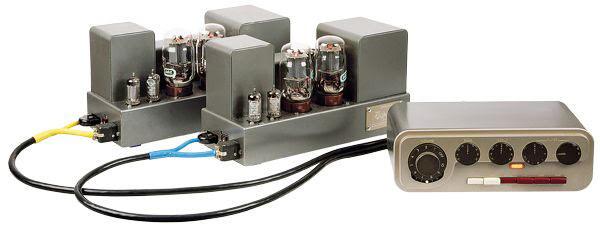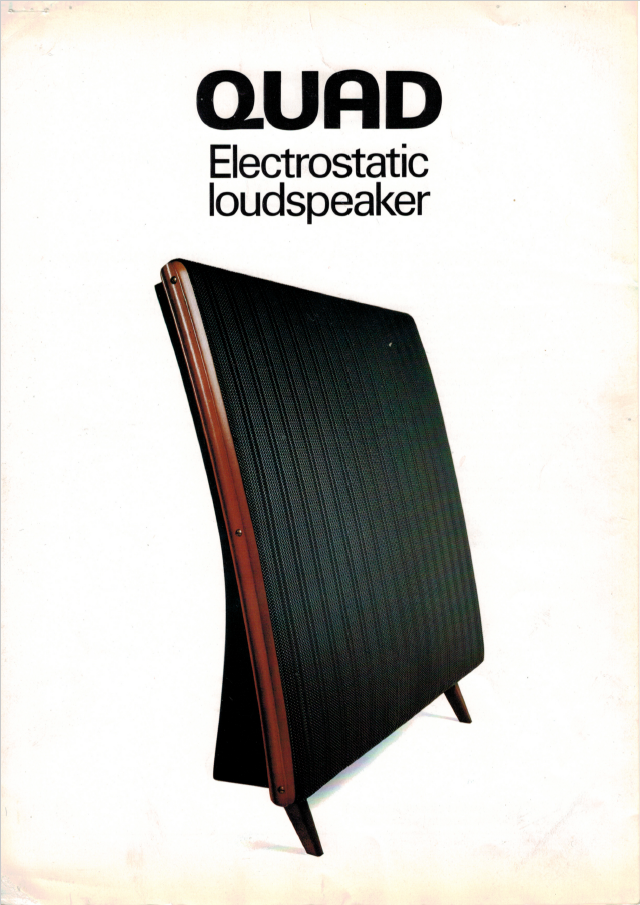Hi-Fi Hall of Fame
Equipment Inductee
Quad ESL-57 Loudspeaker

Introduction
The Quad ESL-57 Electrostatic Loudspeaker (ESL) was the world’s first production full range electrostatic loudspeaker. It was launched in 1957 by Quad Electroacoustics, which was then known as the Acoustical Manufacturing Co. Ltd.
The original model, often called the “ESL-57”, was a floor standing, flat panel speaker, shaped somewhat like a home electric radiator. Each speaker measured 31 inches high by 34.5 inches wide by 10.5 inches deep (79 cm × 88 cm × 27 cm) and weighed 35 pounds (16 kg).
The original ESL-57 had a metal grille, and three little wooden feet. Earlier versions had a golden bronze grille with teak end caps; later production versions had black grilles and rosewood end caps. The speaker’s electronic components, consisting of an audio transformer, power supply, crossover, and power (mains) transformer, were attached to the rear of the cabinet.

The original ESL loudspeaker was produced from 1957 until 1985. That model was eventually succeeded in 1981 by the ESL-63, which remained in production until 1999. Quad continues to manufacture electrostatic speakers today, decades after the launch of the original design.
Key Facts
| Manufacturer | Quad Electroacoustics (Acoustical Manufacturing Company) |
| Model | ESL-57 |
| Category | Floor Standing Electrostatic Loudspeaker |
| Key Technologies | Electrostatic drivers Infinite Baffle cabinet |
| Years in Production | 1957 – 1985 |
| Inducted into the Hi-Fi Hall of Fame | March 2023 |
Technologies
The ESL-57 was really a groundbreaking design when introduced in 1957. Virtually all hi-fi speakers in that era employed conventional dynamic speakers, employing a paper cone driven by a voice coil and magnet. The Quad ESL-57 did not employ any dynamic speakers, but instead used electrostatic drivers across the entire audio spectrum.
The concept of an electrostatic speaker was originally patented in 1934 by Edward W. Kellogg who was working for General Electric. Here’s a link to that original patent, along with drawing from that original patent application.
https://patents.google.com/patent/US1983377

The electrostatic driver used in the ESL-57 was designed by the company’s founder, Peter Walker. Walker demonstrated a prototype electrostatic panel speaker at the British Sound Recording Association Annual Exhibition in May 1955. After two more years of development, the ESL-57 went into commercial production in 1957.
Each driver in the ESL-57 employed a thin, flat membrane made of a novel material called Mylar. Mylar was developed and manufactured by Dupont and was introduced in 1949. To use Mylar as a speaker, Quad coated the Mylar panel with a thin layer of conductive material which was suspended between two perforated metal stators. When an audio signal was applied to the stators, an electric field is created that causes the Mylar panel to vibrate, producing sound waves.
The ESL-57 employed three separate electrostatic driver panels, two for low frequencies and one for middle and high frequencies. The high frequency panel was subdivided into midrange and tweeter sections, with each section driven separately.
The ESL-57 had to be plugged into a wall outlet (mains) and must be charged prior to use. This is because the diaphragm operates in a “constant charge” mode, and it takes time for the charge to build up. In practice, the speaker is usable after charging for less than half a minute, but the sound gradually improves as the charge builds up. The best performance was achieved when the speaker had charged fully, which could take up to an hour. The electricity is only to charge the diaphragm, so consumption was negligible. The ESL-57 could operate with North American (100-120 volts) or European (200-250 volts) power.
Performance
Electrostatic speaker designs like the ESL-57 have some specific strengths and weaknesses compared to conventional dynamic speakers.
The main strengths of a good electrostatic speaker are the very fast transient response and low distortion. The mylar film of the electrostatic speaker is quite lightweight and it is “driven” across it’s entire surface, so the sound can be very “quick” and accurate. The ESL-57 driver, being only 0.00137 inch thick and weighing only 3 milligrams, was capable of stopping and starting seemingly instantaneously with no damping necessary to the drive units. By comparison, a conventional speaker employs a paper or metal cone which are much heavier and are driven from a single point (the voice coil), which can cause the sound to be “slower” and distorted.
Another advantage for the ESL-57 was the use of an “infinite baffle” cabinet. The cabinet was completely open in the front and rear so there were no resonances or colorations caused by the enclosure.
The weaknesses of electrostatic speakers are that they had limited low frequency capacity, limited high frequency dispersion, and could be difficult to drive. The ESL-57, unfortunately, had all of these traits.
The ESL-57 usable frequency response was only about 50 Hz to 10 kHz. The low end was limited by the fact that the mylar driver could not move very far, which limited bass output. The high end began to taper above 10 kHz and was down as much as 20 dB at 20 kHz. While this frequency response was sufficient for most people and most music, it was not as good as it’s competitors.

The speaker’s flat panel design made them rather directional at high frequencies, and the general practice was to point the speaker directly at the listener. This meant that anybody sitting “off axis”, or indeed standing up, would not hear all of the higher frequencies.
The speaker was rather hard to drive for an amplifier, as the impedance was quite high (15 to 30 Ohms) in the 40 Hz to 8 kHz range, and then falling to as low as 2 Ohms at 20 kHz. The load that it presented to the amplifier was also highly capacitive. Quad did manufacture a number of amplifiers which were designed to work well with the ESL-57. These amplifiers incorporated limiters to ensure that the voltage did not exceed safe levels for the speaker.


Despite these shortcomings, the speakers were very highly regarded by many people. Stereophile magazine described the speaker as having been designed for “serious music” (classical) listeners who play records more for musical enjoyment than for the sound.


Impact
The launch of the ESL-57 was eagerly awaited by the audiophile community. Even before it was launched, several articles were written about it in Wireless World in 1955, and it appeared on the cover of the 1956 Hi-Fi Yearbook. Generally well-received from its launch, the speaker was dubbed “Walker’s Wonder” very early on. The loudspeaker was used as a studio monitor for controlling the sound quality of broadcasts.
The original ESL, in production between 1957 and 1985, sold 54,000 pairs during its life. Despite some major weaknesses, it is universally hailed as one of the most important speakers of the 20th century. Home Theater Review said it was “the most cherished hi-fi product ever”. The magazine “What Hi-Fi?” notes the fanatical loyalty from owners of the speaker or fascination from people who yearn to own them. Demand for second hand versions of the original speakers remains robust many years after their being discontinued.

Quad is still in business, and the company continues to manufacture electrostatic speakers along with a wide range of other hi-fi products. Here’s a link to their website if you would like to take a look.
Induction to the Hi-Fi Hall of Fame
The Quad ESL-57 introduced an entirely new technology, the electrostatic speaker, to the audio community. Even though it was the first of it’s kind, it was a great speaker that made many audiophiles very happy. The Quad ESL-57 is inducted into the Hi-Fi Hall of Fame.
